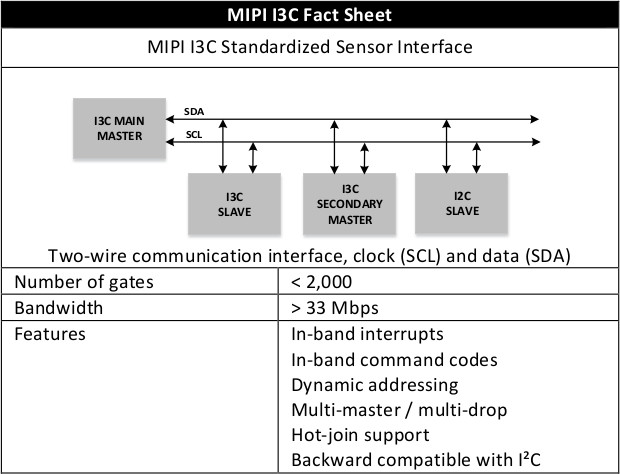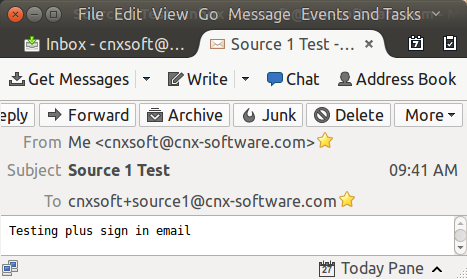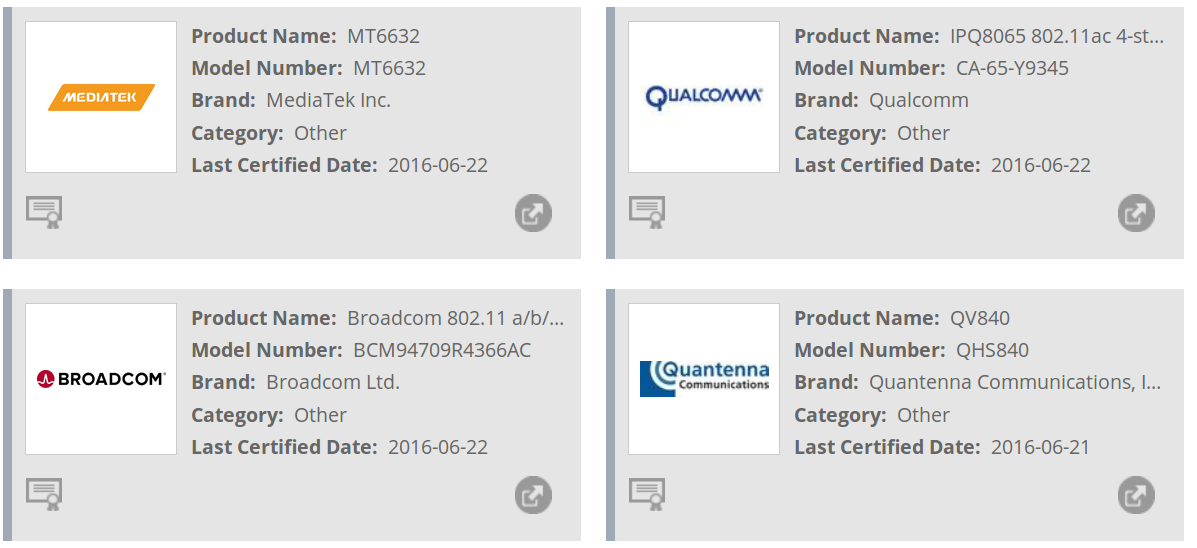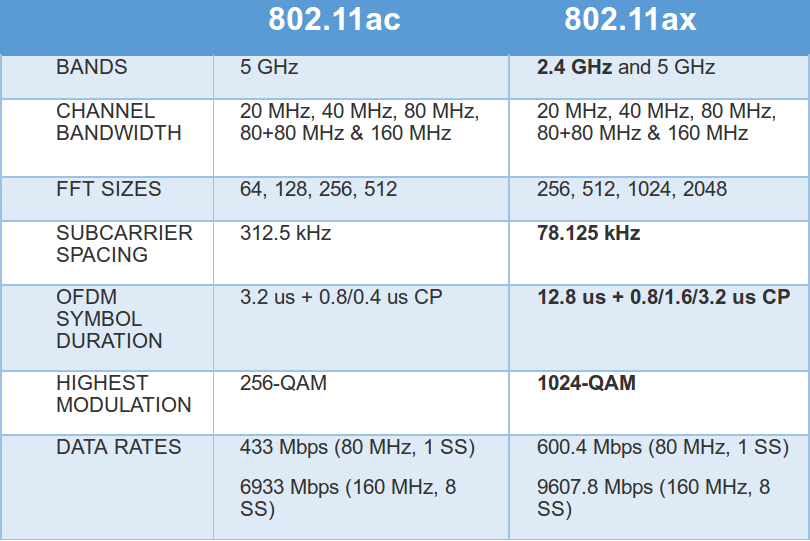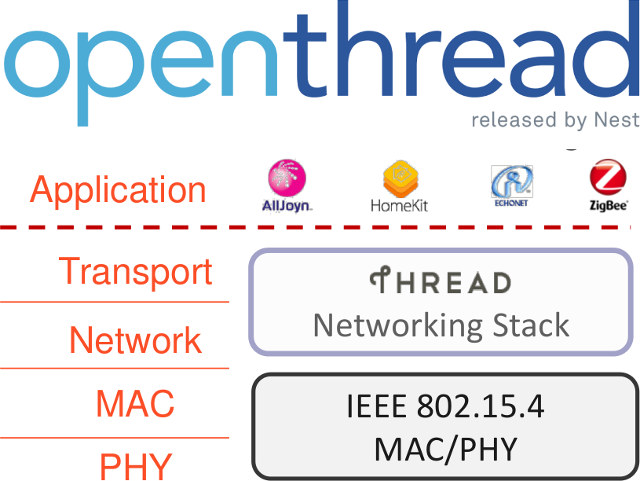Most recent 4K Ultra HD televisions support high dynamic range (HDR) through standards such as HDR10, Dolby Vision, or Hybrid Log-Gamma (HLG). Samsung and Amazon have jointly introduced an update to HDR10 with HDR10+ that adds dynamic tone mapping & metadata. The companies describe the issues for HDR10′ static metadata as follows: The current HDR10 standard utilizes static metadata that does not change during playback despite scene specific brightness levels. As a result, image quality may not be optimal in some scenes. For example, when a movie’s overall color scheme is very bright but has a few scenes filmed in relatively dim lighting, those scenes will appear significantly darker than what was originally envisioned by the director. HDR10+ will be able to adjust metadata for each scene, and even for each frame, hence solving the issue of darker scenes. If you already own a Samsung TV with HDR10, it’s not […]
MIPI I3C Sensor Interface is a Faster, Better, Backward Compatible Update to I2C Protocol
I2C (Inter-Integrated Circuit) is one of the most commonly used serial bus for interfacing sensors and other chips, and use two signals (Clock and Data) to control up to 128 chips thanks to its 7-bi address scheme [Update: That’s the theory, as in practice it’s limited to a dozen devices max. due to capacitive load, see comments]. After announcing it was working of a new I3C standard in 2014, the MIPI Alliance has now formally introduced the MIPI I3C (Improved Inter Integrated Circuit) Standardized Sensor Interface, a backward compatible update to I2C with lower power consumption, and higher bitrate allowing it to be used for applications typically relying on SPI too. I3C offers four data transfer modes that, on maximum base clock of 12.5MHz, provide a raw bitrate of 12.5 Mbps in the baseline SDR default mode, and 25, 27.5 and 39.5 Mbps, respectively in the HDR modes. After excluding […]
Adding Plus Sign and Tag to Email Address May Help Identify Source of (Spam/Junk) Emails
I’ve noticed several commenters using email formatted as [email protected] or [email protected] while posting comments on CNX Software blog, but I just thought they were using some specific emails account or some forwarding techniques to receive emails, but I did not investigate further, and by chance I came across the reason on reddit this morning: It’s just another character that can be in an email address. For example, [email protected], [email protected], [email protected], and [email protected] are all completely different email addresses. However, Gmail will ignore a + and everything after it in the username portion of an email address, so [email protected], [email protected], and [email protected] will all go to [email protected]‘s inbox. This is acceptable because Google does not allow + in its login names. Many people use this property to identify the source of an email. So I could not resist trying by sending myself an email by adding +source1 to my username, and […]
Wi-Fi CERTIFIED ac Wave 2 Products Support MU-MIMO, 160 MHz Channels, and More
802.11ac WiFi is now found in many routers and devices, and the Wi-Fi alliance has so far certified close to 3,000 “Wi-Fi CERTIFIED ac” products. I understand that certification is not mandatory, but if you want to make sure a device works well, the certification at least means the devices have been tested for interoperability, security and application specific protocols, and found to work in a satisfactory manner. Now the Wi-Fi alliance has announced Wi-Fi CERTIFIED ac Wave 2 certification program with the following new requirements: MU-MIMO (Multi-user Multiple Input Multiple Output) in order to send data to multiple devices at once to improve overall network efficiency and throughput 160 MHz channels support (not only 80 MHz) potentially doubling transmission speeds Four spatial streams instead of just three spatial streams. Extended 5 GHz channel support by adding more channels in the 5 GHz to reduce interference and congestion. Currently the […]
AOMedia AV1 is a Royalty-free, Open Source Video Codec Aiming to Replace VP9 and Compete with H.265
The Alliance for Open Media, or AOMedia, is a new non-profit organization founded in 2015 by Amazon, Cisco, Google, Intel Corporation, Microsoft, Mozilla, and Netflix, and more recently joined by AMD, ARM, and NVIDIA, whose first project is to develop AV1 royalty-free and open video codec and format to provide an alternative to H.265 / HEVC, and a successor to VP9. The project is a team effort combining teams working on Daala, Thor, and VP10 video codecs, and while AFAIK, AV1 specifications have not been released yet (target: Q1 2017), the organization has already released an early implementation of AV1 video decoder and encoder under the combination of an BSD-2 clause license and the Alliance for Open Media Patent License 1.0 , which can be found on googlesource.com. So I’ve had a quick my myself following the instructions, by first downloading one uncompressed YUV4MPEG sample:
|
1 2 3 4 |
mkdir ~/derf_cif pushd ~/derf_cif wget http://media.xiph.org/video/derf/y4m/husky_cif.y4m popd |
and the source code:
|
1 2 |
git clone https://aomedia.googlesource.com/aom cd aom |
[…]
Bluetooth 5 Promises Four times the Range, Twice the Speed of Bluetooth 4.0 LE Transmissions
The Bluetooth SIG is about to officially unveil Bluetooth 5 on June 16 during a media event in London. One change on the marketing side is that they dropped the point number, so it won’t be called Bluetooth 5.0 like in Bluetooth 4.0, but just Bluetooth 5. The decision has been made allegedly to “simplifying marketing, and communicating user benefits more effectively”. On the technical side, Bluetooth 5 will double the speed and quadruple the range of low energy Bluetooth transmissions compared to Bluetooth 4.x, which could be important for IoT applications where nodes are connected throughout the house. Bluetooth 5 will also allow connectionless services to add location-relevant information and navigation. The specifications have not been publicly released yet, and made they will be on June 16. Eventually, you’ll be able to download them on Bluetooth “adopted specifications” page. Via XDA developers Jean-Luc Aufranc (CNXSoft)Jean-Luc started CNX Software in […]
802.11ax WiFi Aims to Deliver Higher Throughput (Up to 10 Gbps), Better Handle High Density Scenarios
802.11ax WiFi, also known as High-Efficiency Wireless (HEW), aims to improve the average throughput per user by a factor of at least 4 times in dense user environments, with a total bandwidth of 10 Gbps over 2.4 and 5.0 GHz . The new standard is still work in progress and is expected to be published in 2019. 802.11ax WiFi key features include: Backwards compatible with 802.11a/b/g/n/ac Increase 4x the average throughput per user in high-density scenarios, such as train stations, airports and stadiums. Data rates and channel widths similar to 802.11ac, with the exception of new Modulation and Coding Sets (MCS 10 and 11) with 1024-QAM. Specified for downlink and uplink multi-user operation by means of MU-MIMO and Orthogonal Frequency Division Multiple Access (OFDMA) technology. Larger OFDM FFT sizes (4x larger), narrower subcarrier spacing (4x closer), and longer symbol time (4x) for improved robustness and performance in multipath fading environments […]
OpenThread is an Open Source Implementation of Thread IoT Networking Protocol
Thread was announced about two years ago, as a new IP-based wireless protocol based on 6LoWPAN and 802.15.4 standards and targeting IoT applications. Nest Labs, an Alphabet company, has now released OpenThread open-source implementation of the networking protocol under a BSD license. The source code (C++) for OpenThread includes supports for End Device, Router, Leader & Border Router roles, and can be found on Github. The implementation is said to be OS and platform agnostic with a radio abstraction layer, have a small footprint, and implement all Thread networking layers, namely IPv6, 6LoWPAN, IEEE 802.15.4 with MAC security, Mesh Link Establishment, and Mesh Routing. To quickly get started, you may want to read the Examples README which explains how to build the code, start two nodes, and ping them. Interestingly, while the code is there for everybody to use, only paid members ($2,500 to $100,00) of the Thread group can […]



